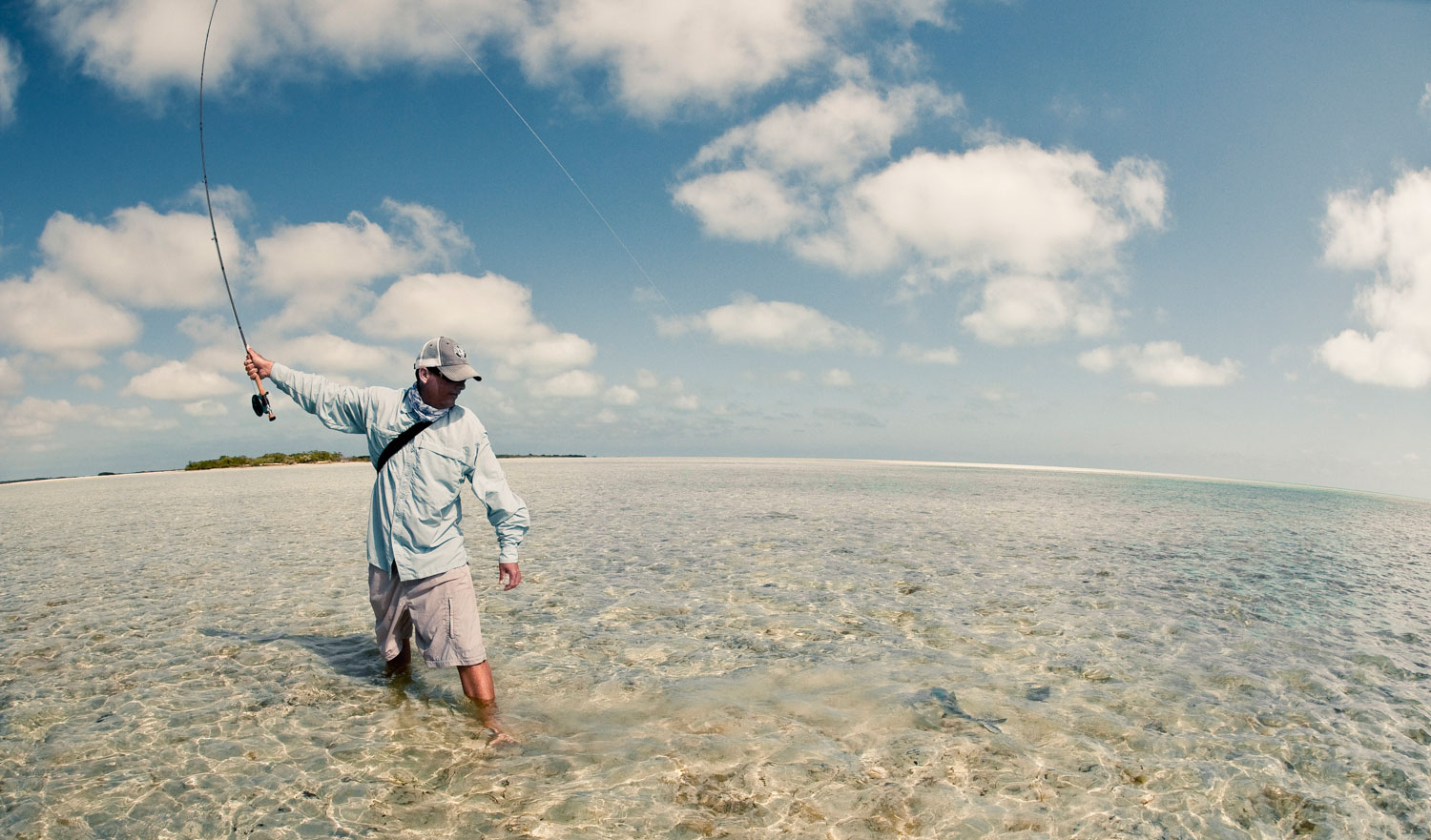by Bruce Chard
Wading is an exciting way to experience saltwater flats fishing for species like bonefish and permit. It offers the angler a more personal, mano y mano, experience with his quarry. There are a few skills you’ll need to master for a quality wading experience. These tips should make walking the flats a breeze.
The Wading Ready Position
While wading the saltwater flats, it’s important to find a good, comfortable ready position. This position will help you be relaxed as you stroll quietly through the shallows. You’ll be ready to make a saltwater quick cast with ease.
Here are some pointers that make up a good wading ready position.
•Have the fly line, coming from the first stripping guide, pinched to the cork with your index finger. This helps to load the rod quickly on your first false cast.
•Hold the fly at the bend of the hook or cradled comfortably in your cupped hand.
•Do not let the fly touch anything, from the start of the cast until you present it to the fish. Some anglers like to drop the fly in the water and then cast. This motion causes all kinds of issues. They usually hook themselves and miss the shot.
•You can tuck the cork handle of the rod under you arm pit with the rod tip sticking out behind you . This is a nice way to relax a little and stretch your hands
Line Management While Wading
Here are a couple of fly line management tips that will help you when wading.
•Make sure to have enough line off the reel to make the cast. There will be no time to strip more off once you spot a fish.
•Make sure your leash (the amount of line outside your rod tip while in the ready position) is not too long or short. Usually around 9ft of fly line and the leader makes a very comfortable and manageable leash.
•Try not to hold more than one loop in your running line, dragging in the water behind you. Too many loops will cause tangles
•If there is current where you are wading, it’s best to get all of your running line next to your legs so it can shoot through your guides easily.
Landing Bonefish When Wading
Trying to land saltwater fish, even smaller ones like Bonefish, if done incorrectly can result in a lost fish or even a broken rod. Here are some does and don’ts.
•Try to leave at least the whole leader and a couple feet of fly line outside the rod tip when making the attempt to land a bonefish.
•Make a large arc, with your rod high over your head. To achieve this, extend your rod arm straight and upward behind you. Bend your wrist backwards to create a nice arc. This will not stress the rod tip and cause it to break.
•Reach for the leader with your line hand, while you guide the fish in towards you with your rod. Use the thumb of your rod hand to support the rod, adding guidance and direction.
•Once you get the leader in your line hand you can then relax your rod, allowing it to straighten.
•Keeping the bonefish in the water, roll him over on his back. This will calm the fish and make it easier to remove the fly.
Remember, if you try to land a bonefish with too little line outside the rod tip, you’ll put too much stress on the rod tip and may cause it to break. The top half of the fly rod is designed to cast the line. The bottom half of the rod is designed to fight the fish.
Next time you go flats fishing, try wading. It’s an exciting way to fish for saltwater species. Just keep these tips in mind and you’ll be good to go!
Bruce Chard Gink & Gasoline www.ginkandgasoline.com hookups@ginkandgasoline.com Sign Up For Our Weekly Newsletter!


Great tips for wading the marsh flats of Georgia as well. I usually let the running line trail behind me as I wade and then pull it to my side when it is time to cast. Since we are stalking a fish, time is on our side, quick casts are the exception not the rule.
Hand to hand combat. I like it! Great tips, Bruce, many of which took a lot of trial and error for me to learn over years of wading. It’s helpful to see all these important pointers in one place. I fully agree that wading is more exciting and at times more productive in bonefishing and redfishing, and I happen to enjoy it more than standing on the bow or worse yet sitting in the well waiting my turn to fish.
I would add that wearing drab clothing (as shown in Louis’ picture); not being in a hurry for both safety (avoiding stepping on stingrays and other issues) as well as for stealth; planning for wind and direction of the sun in your approach; and keeping up a systematic scan for quarry that includes the water behind you, will all add to your success.
Many times it is the small things done right that collectively yield success.
…and slide your feet so you don’t get a stingray surprise
Pingback: April 25, 2014: TGIF Link Round-Up | Feather and Fin